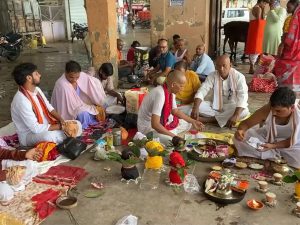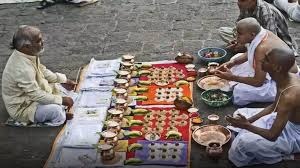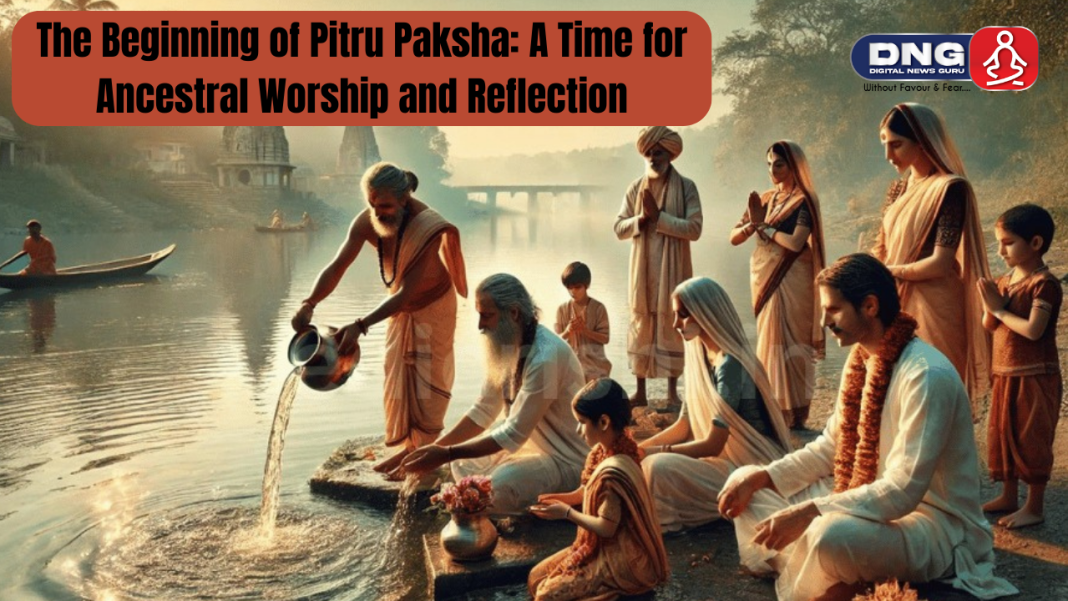DIGITAL NEWS GURU RELIGIOUS DESK:
The Beginning of Pitru Paksha: A Time for Ancestral Worship and Reflection
As of September 18, 2024, Hindus across India and the world are observing the beginning of Pitru Paksha, a 15-day period dedicated to honoring their ancestors.
This annual observance, also known as the Shradh or Pitr Paksha, marks a deeply spiritual time in the Hindu calendar, during which individuals perform rituals to express gratitude, seek blessings, and ensure peace for the souls of their forefathers.

Pitru Paksha commences after the conclusion of the grand Ganesh Chaturthi festival and continues until the new moon, known as Mahalaya Amavasya. It culminates in the celebration of Mahalaya, which is also considered the starting point of preparations for the major Hindu festival of Durga Puja. During this period, Hindus believe that the souls of their ancestors visit Earth, offering a rare and sacred opportunity for the living to strengthen their spiritual ties with the deceased.
The Significance of Pitru Paksha
Pitru Paksha is a deeply embedded tradition in Hindu cosmology and is closely associated with the concept of Karma. According to Hindu beliefs, the deeds of one’s life—whether good or bad—determine the fate of the soul in the afterlife. The living descendants play a crucial role in ensuring that the souls of their forefathers find peace and salvation. The rituals performed during Pitru Paksha, known as Shradh or Tarpan, are seen as a means of purifying past mistakes and ensuring spiritual grace for both the ancestors and the living descendants.
These rituals usually include offerings of food and water, prayers, and recitations from sacred texts like the Garuda Purana and Bhagavad Gita. It is believed that by performing these rituals with sincerity, the departed souls are appeased and, in return, offer their blessings to the family. One of the main objectives of Shradh is to liberate ancestors from any unfulfilled desires or attachments that could hinder their spiritual progression. This ensures their transition to higher spiritual planes and brings peace to their soul.
The Rituals of Pitru Paksha
Shradh rituals are traditionally performed by the male members of the family, especially the eldest son or male relative. The offerings, also called Pind Daan, often consist of cooked rice, barley, and sesame seeds, which are considered essential offerings in the ceremonies. The rituals are usually conducted on the banks of rivers or other sacred bodies of water, with holy places like Gaya, Haridwar, and Varanasi being particularly significant.
In addition to the offerings, the feeding of Brahmins and the poor is an important part of Shradh. It is believed that serving food to the needy in memory of one’s ancestors is a way of earning their blessings and ensuring peace in the family. During Pitru Paksha, people also refrain from certain activities like celebrating festivals, conducting weddings, or making large financial purchases. This period is one of solemnity, reflection, and reverence for the past.
The Mythology Behind Pitru Paksha

The significance of Pitru Paksha is rooted in ancient Hindu mythology. According to legend, when Karna, the great warrior from the Mahabharata, passed away and reached the afterlife, he was offered gold and jewels instead of food. Confused and hungry, he asked Yama, the god of death, why he was being denied sustenance. Yama explained that while Karna had been generous in life, donating vast amounts of wealth, he had never offered food to his ancestors. Realizing his oversight, Karna requested the opportunity to return to Earth to rectify his mistake. He was granted 15 days to do so, which became the origin of Pitru Paksha.
This myth underscores the importance of feeding one’s ancestors through ritual offerings, as well as the profound connection between the living and the dead. It also highlights the belief that the deeds performed during one’s lifetime—particularly in relation to honoring one’s forefathers—have a significant impact on the soul’s journey in the afterlife.
Astronomical and Cultural Coincidence: Supermoon and Pitru Paksha

Interestingly, the beginning of Pitru Paksha in 2024 coincides with the occurrence of the last Supermoon of the year, adding a symbolic dimension to this period of reflection. The Supermoon, which appears larger and brighter due to its proximity to Earth, is seen as a symbol of illumination and completion. The celestial event serves as a reminder of the cyclical nature of life and the universe, mirroring the spiritual cycles acknowledged in Hinduism.
The timing of Pitru Paksha with a celestial event such as the Supermoon offers an opportunity for people to reflect not only on their spiritual connections but also on their place in the broader universe. The full moon’s brightness can be seen as a metaphor for shedding light on hidden or forgotten aspects of one’s lineage, inviting introspection and gratitude.
Cultural Parallels and Global Practices
While Pitru Paksha is primarily a Hindu observance, the reverence for ancestors and the practice of offering prayers for the dead is a universal theme found across various cultures. In China, for instance, the Hungry Ghost Festival is a time when offerings are made to appease wandering spirits. Similarly, in Japan, the Obon festival is dedicated to honoring the spirits of deceased relatives. These parallels underscore the common human desire to maintain a connection with the past and to seek blessings from those who came before.
YOU MAY ALSO READ: Prime Minister Narendra Modi’s 74th Birthday: A Day of Celebrations and Major Initiatives








